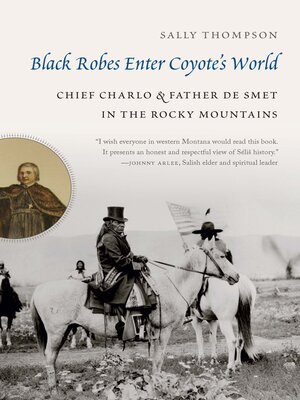Black Robes Enter Coyote's World
ebook ∣ Chief Charlo and Father De Smet in the Rocky Mountains
By Sally Thompson

Sign up to save your library
With an OverDrive account, you can save your favorite libraries for at-a-glance information about availability. Find out more about OverDrive accounts.
Find this title in Libby, the library reading app by OverDrive.



Search for a digital library with this title
Title found at these libraries:
| Library Name | Distance |
|---|---|
| Loading... |
Black Robes Enter Coyote's World brings to life the complicated history of Jesuit missionaries among Montana's Native peoples—a saga of encounter, accommodation, and resistance during the transformative decades of the mid-to-late nineteenth century. Sally Thompson tells the story of how Jesuit values played out in the lives of the Bitterroot Salish people. The famous Black Robe (Jesuit) Father Pierre-Jean De Smet actually spent little time among his "beloved Flatheads." Instead, he traveled extensively between the Pacific and the Rockies, mapping the pathways and noting the valuable resources. His popular writings helped spark the westward movement of white settlers.
Thompson picks up the story of the Salish peoples and black-robed missionaries at a Potawatomi mission on the Missouri in 1839 and follows their intertwined experiences throughout the lifetime of Salish chief Charlo, who eventually cursed the day white immigrants came into his country. Chief Charlo attributed the missionaries' disconnected beliefs and exploitative actions to their status as orphans rejected from their place of creation, as he had learned from the story of Eden. Despite Charlo's valiant efforts to protect his homeland, the Salish endured a forced removal from their beloved Bitterroot Valley to the Flathead Reservation in 1891. Charlo died in 1910, just before the massive giveaway of more than half of the Salish's treaty-guaranteed lands through implementation of the Allotment Act. Despite it all, his people endure.
In this up-close account of the Bitterroot Salish people during the lifetime of Chief Charlo, Thompson examines the fundamental differences in the ways Euro-Americans and Native Americans related to land and nature.
Thompson picks up the story of the Salish peoples and black-robed missionaries at a Potawatomi mission on the Missouri in 1839 and follows their intertwined experiences throughout the lifetime of Salish chief Charlo, who eventually cursed the day white immigrants came into his country. Chief Charlo attributed the missionaries' disconnected beliefs and exploitative actions to their status as orphans rejected from their place of creation, as he had learned from the story of Eden. Despite Charlo's valiant efforts to protect his homeland, the Salish endured a forced removal from their beloved Bitterroot Valley to the Flathead Reservation in 1891. Charlo died in 1910, just before the massive giveaway of more than half of the Salish's treaty-guaranteed lands through implementation of the Allotment Act. Despite it all, his people endure.
In this up-close account of the Bitterroot Salish people during the lifetime of Chief Charlo, Thompson examines the fundamental differences in the ways Euro-Americans and Native Americans related to land and nature.







